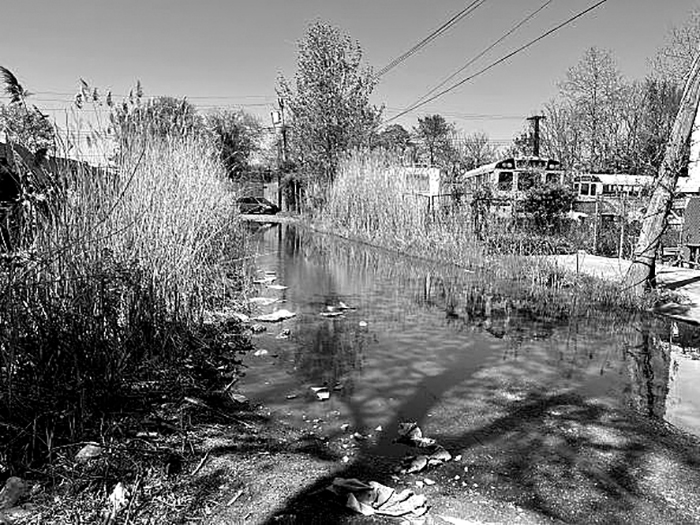Photo Courtesy of City Department of Housing Preservation and Development
Flooding on Amber Street in the Jewel Streets neighborhood.
By Forum Staff
Mayor Eric Adams on Thursday kicked off the Jewel Streets Neighborhood Plan, an effort to deliver much-needed quality of life improvements to the “Jewel Streets” neighborhood, also known as “the Hole,” on part of the Brooklyn/Queens border.
Backed by more than $75 million in initial funding, the Adams administration’s planning process aims to bring resiliency measures to this chronically flood-prone area, improve street infrastructure and pedestrian safety, and create new, affordable housing and economic opportunity for residents of this 12-block neighborhood that straddles East New York in Brooklyn and Lindenwood in Queens and has long suffered from flooding and been deprived of public investment.
Building on more than a year of engagement with elected officials, community members, and local organizations like the East New York Community Land Trust and the Cypress Hills Local Development Corporation, the New York City Department of Housing Preservation and Development (HPD), in partnership with the New York City Department of Environmental Protection (DEP) and other city agencies, will present ideas to the community for alleviating flooding, build stable and affordable housing on vacant city-owned land, and create economic opportunities.
Because the neighborhood is a low-lying area without comprehensive stormwater and sanitary sewer infrastructure, residents experience year-round flooding, even on sunny days. Most streets in the neighborhood today contain open industrial uses or overgrown, vacant lots, including a 17-acre City-owned site. And though wild plants grow tall along street edges, industrial uses and septic tank leaks have contaminated the land and groundwater. Pedestrian safety has also been an ongoing challenge, with few sidewalks or crosswalks available for pedestrians and tractor trailers, recreational vehicles, and other abandoned vehicles frequently stored on the street.
Beginning this month, the Adams administration will kick off a community planning proposal where residents will be able to weigh in on a series of tools to address flooding, including a bluebelt and a drainage pond to divert rainwater from sewers; green infrastructure, like rain gardens to provide additional capacity to absorb rainwater; upgraded sewers with expanded capacity to serve as the first line of defense against flooding from rain events; and additional supportive tools such as raised streets. Community members will also have an opportunity to share perspectives on ways the city can make streetscape upgrades to improve safety and connectivity to nearby neighborhoods, create affordable housing on city-owned land, stimulate the creation of good jobs and community amenities, and develop a long-term land use and zoning plan.
In partnership with the community, the administration will develop targeted resiliency strategies for the respective areas north and south of Linden Boulevard. The city has received $2.5 million in federal Community Development Block Grant Disaster Recovery funds that will go towards planning work around resiliency measures and affordable housing creation. For the northern area, the administration is investing $72.8 million in new and upgraded resiliency infrastructure. In the southern area, community engagement will inform efforts to redirect water to Jamaica Bay and reduce current and future flood risk, explore green infrastructure to further reduce flooding, build new affordable housing, and create retail space and good-paying jobs.
The planning process, which will cover both sides of Linden Boulevard, is organized around five core goals:
- Build resilient, green infrastructure and improve community resilience.
- Outline a community-supported vision for city-owned land, including a 17-acre vacant lot.
- Improve street infrastructure, pedestrian safety, and connectivity to surrounding neighborhoods.
- Facilitate the creation of jobs, community services, and amenities.
- Develop a long-term land use plan for the Jewel Streets.

